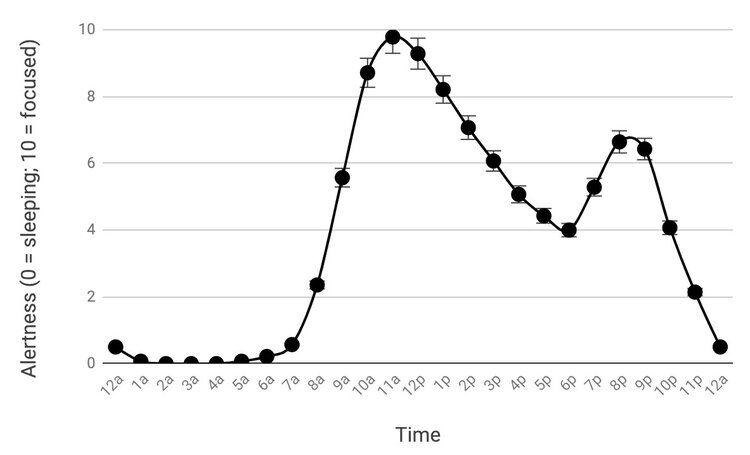The professional world is changing more than ever, particularly with what we have been going through of late. We recently invited Lucas Miller and Dr. Sahar Yousef, two incredible speakers that are neurologists who both teach one of the most popular MBA classes at UC Berkeley and have 10 plus years of research, to discuss the latest impact on our behaviors.
Chronotypes
The first and most important thing explained to us was that everything is centered around ‘Rhythms and waves’. Everything in nature is centered around rhythms, in the physical world, the natural world, and in the human body, from a molecular level to the highest macro level.
Nobel prize-winning research showed that each human has a biologically pre-set circadian rhythm, known as a ‘chronotype’. This internal rhythm dictates our optimal time to fall asleep and wake up, as well as the peaks and troughs that we experience in our daily levels. There is no such thing as a good or bad chronotype, there are just differences in genetics and it is better to know this information to help you function better.
So what are the different Chronotypes? Well, there are three biological chronotypes:
- Type 1 is an AM-shifted chronotype, which 25% of the population have and are described as going to bed early AND waking up early
- Type 2 is a Bi-phasic chronotype, which 50%+ of the population has and peaks at 9 am & 9 pm.
- Type 3 is a PM-shifted chronotype, which 20% of the population have and wake up late and go to bed late.

What this means is that if you are PM-shifted (type 3), then forcing yourself to rise early in the morning to do meditation or a workout, isn’t great advice if you are not already AM-shifted (type 1). It makes no sense to force yourself into a mold that is just not you. Ideally, we should use our individual chronotypes to optimize ourselves as humans, by using the schedules that our bodies biologically work best at. So how can we do that?
Through studies and research, it has been scientifically proven that we can concentrate on focus, communications and rest to optimize ourselves on a daily basis.
Focus
Mckinsey ran a 10-year study that said that people who carve out their optimal focus time are proved to be 5% more effective and productive within this window. The advice is to do it as often as you can, be it as an individual, or a group. The single highest ROI for productivity is a ‘focus sprint‘, whereby on average individuals rate themselves 42% more productive during a focused sprint. A few ways to do this is are:
- Set aside a 1-hour block in the calendar; so people know you are communicating to them what you are doing.
- Write down what you aim to accomplish; this is something that is crucial in scoping out exactly what you have to finish.
- Eliminate distractions, close your email, turn off your phone, and put it out of sight. Sort out your ‘digital hygiene’ which is the relationship you have with your devices and notifications.
- Focus for 50 minutes using a timer; human beings are impacted by ‘markers of progress’ – if you can see the time ticking away, they work better and more efficiently.
- Take a ‘Brain Break’; take some time where you are no longer processing information. That means no reading, writing, or arithmetic.
Communications
Dr. Simon Folkard, University of Sussex said that the biggest mistake as individuals and organizations is scheduling communications at the wrong time. Depending on the time and day, people will:
- Learn faster (information processing speed)
- Remember more (increased processing speed)
- Focus harder (enhanced attention control)
Organizations need to time their employee’s communications based on when they SHOULD receive the message, which is when they are working. Someone pm-shifted is best suited for an evening shift, so THAT is when they should be receiving their messages and communications from their organization. We need to be predictable in communicating to our employees so they know when to expect communications. This then excites them, producing dopamine meaning people will almost certainly read the communications.
A few tips and tricks we learned from Lucas and Dr. Sahar were to:
- Batch your emails and take intervals to check them. Check-in and then check-out and don’t go back to them until the next interval. It has been reported that ‘Batchers’ have greater productivity and lower cortisol.
- Use chronotypes to determine when to have meetings. Get the data and find out everyone’s chronotypes to be able to optimize your workforce.
- Avoid Video fatigue by doing fewer videos calls and meetings—Beta waves are markers of alertness and how much effort your brain has to put in to pay attention and focus. It’s proven that the brain has to use more beta waves during video meetings than when in person, so it’s more neurologically draining. Based on science ’30 is the new 60’ for minutes of (video) meetings to get more out of it and the people.
- ‘Hide self view’—Dr. Saher explained that seeing yourself is one of THE most deeply biologically unnatural things to the human brain that could possibly be happening. The FSA part of the brain has ONE job to do and that is to process the human face. So it is going to be distracting on video calls. It’s biologically unnatural to see yourself when you try to speak to somebody and causes enormous amounts of ‘brain drain’.
Rest
Something everyone needs and to use with biology to optimize rest. It’s documented that more car accidents occur at 2 pm than at any other time of day. The risk of surgery is also highest between 2-3 pm. Why? Because on average everyone’s energy levels are dipping. This period of time therefore should be scheduled for less important routine tasks and admin. Don’t attempt to do high-powered brain thinking during this time as it will just take longer and more mistakes will be made. Most people (Bi-phasics) hit their peak around 9-10 am, so it doesn’t make sense to force workers to start work earlier than what their body is ready for as it will cause a vast array of physical and mental health consequences.
So what’s next and how do we get there?
Lucas and Dr. Saher are confident that introducing Chronotype-based scheduling (CBS) is going to make its way into all types of work and industries. So instead of setting an easy 9-5 schedule, we will see companies setting strategically placed schedules based upon when workers work best and when they should do certain types of work. It has already started with a number of companies, such as AbbVie, Thyssen Krupp and Southwest Airline that are now reaping the rewards from chronotyping their workforce.
Lucas and Dr. Saher shared some incredible information leaving us thinking about how we move forward in optimizing ourselves as human beings but also those around us and in our companies and workforces where we spend the majority of our working days. We now have new tools, new data, and new assessments that we can use to enable workers and ourselves to be more strategic in how we schedule our time. We just need to move forward with the times and the science.
Know your chronotype
Take a Biological Chronotype Assessment (5 minutes). Learn your individual energy profile and how to schedule your day for peak performance (ideal times for focus, collaboration, and creativity).
Achieve communication satisfaction
Download our in-depth report to learn the 5 steps you can take at your organization to increase engagement and improve communication satisfaction, regardless of the location of your employees.
Download PDF








